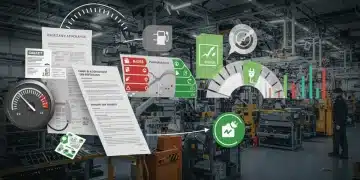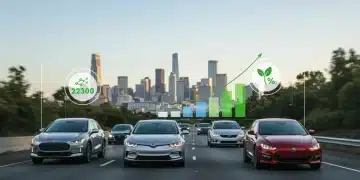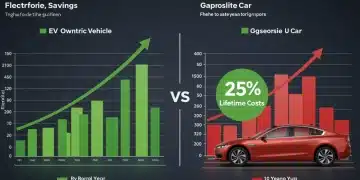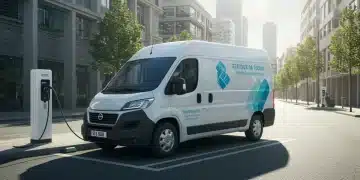Next-Gen Powertrains: Hydrogen Fuel Cell & Advanced Hybrids for 2025 US Models
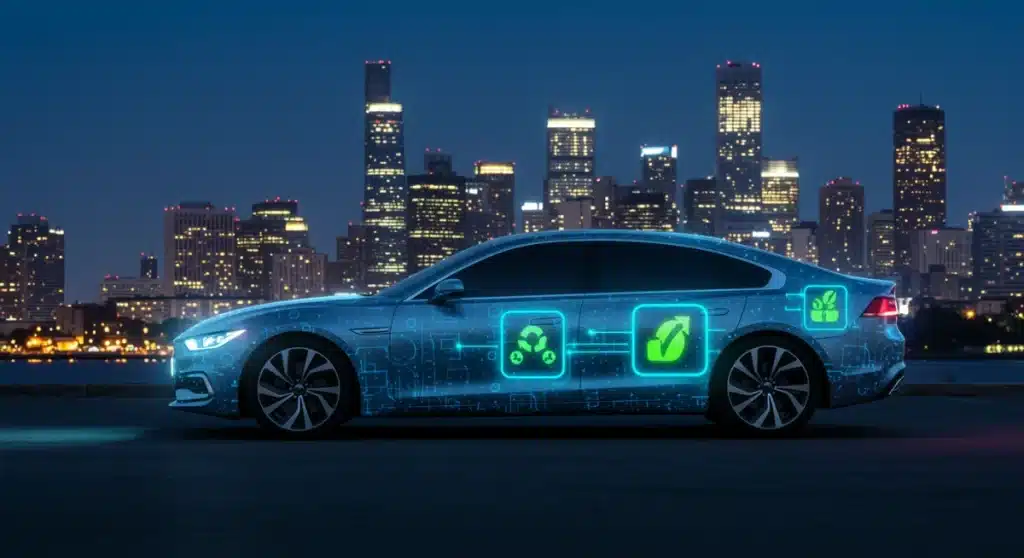
The automotive landscape is undergoing a profound transformation, with next-generation powertrains poised to redefine vehicle performance and environmental impact. As 2025 approaches, US models are set to showcase significant advancements in hydrogen fuel cell and advanced hybrid technologies, promising cleaner, more efficient driving experiences for consumers.
The Rise of Hydrogen Fuel Cell Technology
Hydrogen fuel cell technology is emerging as a critical player in the quest for zero-emission vehicles. Unlike traditional internal combustion engines, fuel cell electric vehicles (FCEVs) produce electricity through a chemical reaction between hydrogen and oxygen, emitting only water vapor. This clean energy conversion offers a compelling alternative to battery electric vehicles (BEVs), particularly for applications requiring longer ranges and faster refueling times.
Recent developments indicate a surge in investment and research, with several major automakers committing to expanding their FCEV lineups. The infrastructure for hydrogen fueling, while still in its nascent stages, is also seeing gradual growth, especially in key markets. This push is driven by both environmental mandates and the desire to offer diverse powertrain options to consumers.
Advancements in Fuel Cell Efficiency
Engineers are continually refining fuel cell stacks to improve efficiency and reduce costs. Breakthroughs in catalyst materials and membrane technology are enhancing power output and durability. These innovations are crucial for making FCEVs competitive with other powertrain options.
- Improved catalyst materials for better performance.
- Enhanced proton exchange membranes for durability.
- Optimized stack designs for higher power density.
- Reduced manufacturing costs through automation.
Expanding Hydrogen Infrastructure
A key challenge for FCEV adoption remains the limited hydrogen fueling infrastructure. However, as of late 2024, new initiatives are underway to expand the network of hydrogen stations, particularly in California and the Northeast US. Government incentives and private sector partnerships are accelerating this crucial development.
The increasing availability of hydrogen production from renewable sources, such as green hydrogen generated through electrolysis powered by solar or wind energy, is also bolstering the viability of FCEVs. This ensures that the entire lifecycle of the vehicle, from fuel production to tailpipe emissions, is environmentally friendly.
Innovations in Advanced Hybrid Technologies
Advanced hybrid technologies continue to evolve, offering a bridge between conventional gasoline vehicles and fully electric options. For 2025 US models, expect to see more sophisticated hybrid systems that deliver unprecedented fuel efficiency and reduced emissions without range anxiety. These systems often combine smaller, more efficient internal combustion engines with powerful electric motors and larger battery packs.
Plug-in Hybrid Electric Vehicles (PHEVs) are at the forefront of this evolution, providing significant electric-only range for daily commutes before seamlessly switching to hybrid mode for longer journeys. Manufacturers are focusing on optimizing the integration of these components, resulting in smoother transitions between power sources and enhanced overall performance.
Next-Generation Hybrid Powertrain Design
The design of advanced hybrid powertrains for 2025 models is moving towards greater electrification. This includes more powerful electric motors, improved battery chemistry for better energy density, and smarter energy management systems. These advancements allow vehicles to operate in electric-only mode for longer periods and at higher speeds.
Continuously variable transmissions (CVTs) and multi-speed automatic transmissions are being specifically engineered to work in harmony with hybrid systems, further optimizing fuel economy and power delivery. The goal is to maximize the benefits of both electric and gasoline power sources, adapting to various driving conditions dynamically.
Key Players and Their 2025 Commitments
Several automotive giants are making substantial commitments to both hydrogen fuel cell and advanced hybrid technologies for their 2025 US model lineups. Toyota, a pioneer in hybrid technology, continues to invest heavily in FCEVs, with plans to expand its Mirai offering and explore fuel cell applications beyond passenger cars. Honda is also re-entering the FCEV market with a new CR-V based model, signaling renewed interest.
On the advanced hybrid front, Ford and General Motors are introducing new generations of their popular SUV and truck models with highly efficient plug-in hybrid options. European manufacturers like BMW and Mercedes-Benz are also expanding their PHEV portfolios, offering luxury vehicles with impressive electric ranges and performance. These commitments underscore a diverse approach to sustainable mobility, acknowledging that a single solution may not fit all consumer needs.
Toyota’s FCEV Expansion
Toyota’s continued dedication to hydrogen is evident in its strategy for 2025. The company is not only refining its Mirai sedan but also exploring fuel cell applications for commercial vehicles and heavy-duty trucks. This multi-faceted approach aims to establish hydrogen as a viable energy source across various transportation sectors.
- Refinement of Mirai fuel cell technology.
- Development of fuel cell systems for commercial use.
- Investment in hydrogen production and distribution.
Ford and GM’s Hybrid Push
American automakers are significantly increasing their hybrid offerings. Ford’s F-150 PowerBoost hybrid has already demonstrated strong market acceptance, and future models are expected to build on this success with even greater efficiency and electric capabilities. GM is also integrating advanced hybrid systems into its popular SUV and truck lines, aiming to reduce fleet emissions while maintaining performance.
Performance and Efficiency Benchmarks for 2025
For 2025 US models, the benchmarks for performance and efficiency in next-generation powertrains are set to rise significantly. Hydrogen FCEVs are targeting longer ranges, often exceeding 400 miles on a single tank, coupled with refueling times comparable to gasoline vehicles, typically under five minutes. This addresses a major concern for long-distance drivers and commercial fleets. Advanced hybrids, particularly PHEVs, will boast expanded electric-only ranges, with many models expected to offer 40 to 60 miles of pure electric driving, effectively covering most daily commutes without engaging the gasoline engine.
Beyond range, improvements in acceleration and overall driving dynamics are also a focus. Electric motors, whether in FCEVs or hybrids, provide instant torque, contributing to a responsive and engaging driving experience. Efficiency gains are not just about miles per gallon or miles per kilogram of hydrogen; they also encompass reduced operational costs and lower maintenance requirements due to fewer moving parts in electric drive systems.
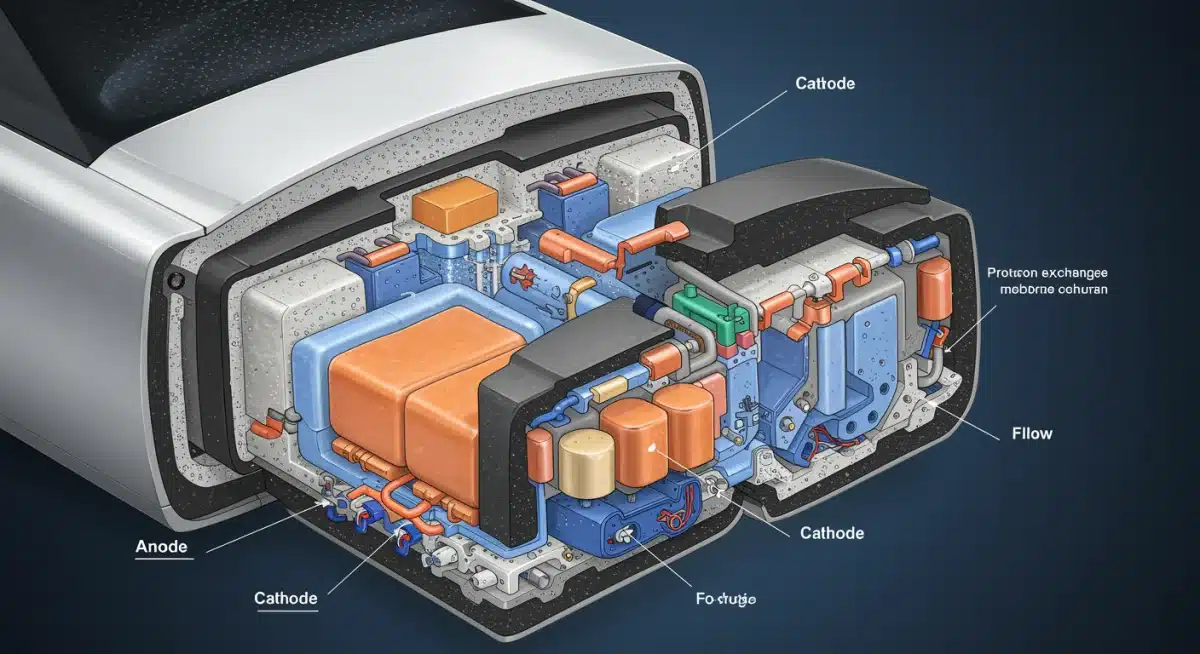
Range and Refueling Advantages of FCEVs
The inherent advantages of FCEVs regarding range and refueling speed are becoming more pronounced. As hydrogen storage technologies improve, vehicles can carry more fuel without significant weight penalties. This makes FCEVs particularly attractive for consumers who frequently undertake long journeys or operate in areas with limited charging infrastructure for BEVs.
The rapid refueling process minimizes downtime, a critical factor for commercial applications such as taxis, buses, and delivery fleets. This efficiency in operation translates directly into increased productivity and reduced running costs over the vehicle’s lifespan.
Environmental Impact and Sustainability Goals
The core motivation behind the development of next-generation powertrains is to mitigate the environmental impact of transportation. Hydrogen fuel cell vehicles produce zero tailpipe emissions, with water vapor as the only byproduct. This directly contributes to improved air quality, especially in urban areas. Advanced hybrid systems, while still utilizing internal combustion engines, significantly reduce greenhouse gas emissions and fuel consumption compared to conventional gasoline vehicles.
The push for sustainability extends beyond emissions to the entire life cycle of these vehicles. Manufacturers are increasingly focused on sourcing materials responsibly, using renewable energy in their production processes, and developing efficient recycling programs for batteries and fuel cell components. The goal is a truly circular economy for automotive manufacturing, minimizing waste and maximizing resource utilization.
Reducing Carbon Footprint
Both FCEVs and advanced hybrids play crucial roles in reducing the automotive industry’s overall carbon footprint. FCEVs, when powered by green hydrogen, offer a path to completely decarbonized transport. Advanced hybrids reduce reliance on fossil fuels and serve as an immediate, practical step towards lower emissions for a broader consumer base.
- Zero tailpipe emissions from FCEVs.
- Significant reduction in CO2 from advanced hybrids.
- Increased use of renewable energy in manufacturing.
- Development of sustainable material sourcing.
Regulatory and Policy Support
Government regulations and policies are critical drivers for the adoption of these sustainable technologies. In the US, stricter emissions standards and various incentives, including tax credits for FCEV and PHEV purchases, are encouraging both manufacturers and consumers to embrace these greener options. These policies are designed to accelerate the transition away from fossil fuels and support the growth of the necessary infrastructure.
Challenges and Future Outlook
Despite the promising advancements, both hydrogen fuel cell and advanced hybrid technologies face distinct challenges as they move towards broader adoption in 2025 and beyond. For FCEVs, the primary hurdles remain the cost of the vehicles, the limited refueling infrastructure, and the production cost of green hydrogen. While progress is being made, these factors currently limit their mass-market appeal.
Advanced hybrids, while more established, face the challenge of continuously improving their electric range and reducing their reliance on fossil fuels, as battery electric vehicles gain market share. The long-term viability of hybrids will depend on their ability to remain a compelling choice for consumers who aren’t ready for a full EV or need the flexibility that hybrids offer. The future outlook, however, remains positive, with continuous innovation expected to address these challenges and further integrate these technologies into the mainstream automotive market.
Overcoming Infrastructure Limitations
The expansion of hydrogen fueling stations is paramount for FCEV success. Collaborative efforts between governments, energy companies, and automakers are essential to build out a robust and accessible network. Similarly, the widespread availability of public charging infrastructure is crucial for maximizing the electric-only benefits of PHEVs.
Technological breakthroughs in hydrogen storage and transportation, as well as faster, more efficient charging solutions for PHEVs, will also play a significant role in overcoming current limitations and making these vehicles more practical for everyday use across the US.
Consumer Adoption and Market Trends
Consumer adoption of next-generation powertrains is a complex interplay of cost, convenience, performance, and environmental consciousness. For 2025 US models, market trends suggest a growing willingness among buyers to consider alternatives to traditional gasoline vehicles. However, education and incentives remain crucial.
Hydrogen fuel cell vehicles, with their long range and quick refueling, appeal to early adopters and those with specific needs, such as commercial fleets. Advanced hybrids, particularly PHEVs, offer a less daunting transition for many, providing electric benefits without range anxiety. As prices decrease and infrastructure improves, wider adoption is anticipated. Marketing efforts will focus on highlighting the unique benefits of each technology, from environmental advantages to performance gains and fuel savings.
Educating the Public on FCEV Benefits
Many consumers are still unfamiliar with hydrogen fuel cell technology. Effective public education campaigns highlighting the benefits – zero emissions, quick refueling, and long range – are vital. Demonstrating the safety and reliability of FCEVs will help build consumer confidence and drive interest in these innovative vehicles.
- Showcasing zero-emission benefits.
- Highlighting rapid refueling times.
- Addressing safety concerns with factual information.
- Promoting government incentives for FCEV purchases.
Hybrid Market Growth
The hybrid market is expected to continue its robust growth, driven by advancements that make them more efficient and powerful. As battery technology improves and electric components become more integrated, hybrids will offer an increasingly attractive balance of fuel economy, performance, and environmental responsibility, serving a broad segment of the US automotive market.
| Key Powertrain Technology | Brief Description for 2025 US Models |
|---|---|
| Hydrogen Fuel Cell (FCEV) | Generates electricity from hydrogen and oxygen, emitting only water; offers long range and fast refueling for 2025 models. |
| Advanced Hybrid Electric (HEV) | Combines gasoline engine with electric motor and battery for enhanced fuel efficiency and reduced emissions. |
| Plug-in Hybrid Electric (PHEV) | Offers significant electric-only range before switching to hybrid mode, rechargeable via external power for 2025 vehicles. |
| Powertrain Efficiency | 2025 models target over 400 miles range for FCEVs and 40-60 miles electric range for PHEVs, improving overall performance. |
Frequently Asked Questions About 2025 Powertrains
For 2025 US models, hydrogen fuel cell vehicles (FCEVs) offer zero tailpipe emissions, long driving ranges often exceeding 400 miles, and rapid refueling times comparable to gasoline cars, typically under five minutes. These advantages address key concerns for consumers seeking sustainable transportation solutions.
Advanced hybrid technologies in 2025 US models feature enhanced electric-only ranges for plug-in hybrids (PHEVs), often 40-60 miles, and more seamless integration of electric motors with gasoline engines. These improvements deliver superior fuel efficiency, reduced emissions, and a smoother driving experience.
Infrastructure is critical. For FCEVs, the expansion of hydrogen fueling stations is essential for broader adoption. For advanced hybrids, particularly PHEVs, accessible public charging infrastructure maximizes their electric-only benefits, making them more convenient for daily use across the US.
Toyota is heavily invested in FCEVs and advanced hybrids, while Honda is re-entering the FCEV market. Ford and General Motors are expanding their advanced plug-in hybrid offerings for SUVs and trucks, and European brands like BMW and Mercedes-Benz are also enhancing their PHEV lineups for 2025 US models.
The main environmental benefits include zero tailpipe emissions from FCEVs, significantly reduced greenhouse gas emissions from advanced hybrids, and overall lower reliance on fossil fuels. These technologies contribute to improved air quality and help meet global sustainability goals for the automotive sector.
Looking Ahead
The landscape of automotive power is undeniably shifting, with 2025 serving as a pivotal year for the widespread integration of advanced hydrogen fuel cell and hybrid technologies in US models. As these next-generation powertrains become more refined and accessible, consumers can anticipate a broader selection of vehicles that offer compelling performance, enhanced efficiency, and a reduced environmental footprint. Watch for continued infrastructure development and further policy support, which will be crucial in shaping the long-term success and adoption rates of these innovative solutions, moving us closer to a sustainable transportation future.
